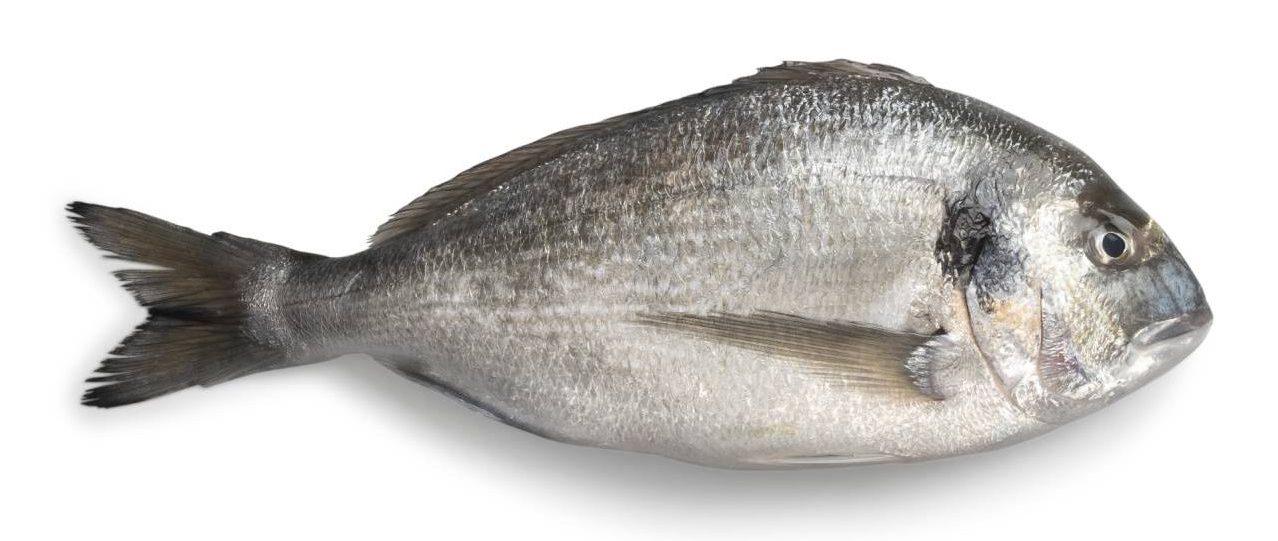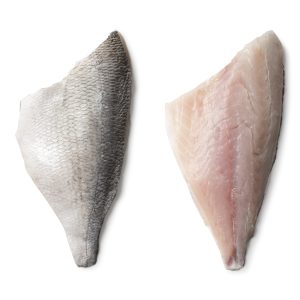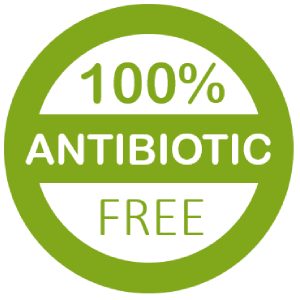
Why Sea Bream from AnT Seafood?
.1
We’re the Sea bream specialists
.2
Supplying fresh & frozen worldwide
.3
flexible and reliable partner
.4
we control the entire process
.5
we guarantee the best price/quality

Sea Bream sizes and grading
Sea Bream Whole fish and fillets
Roughly speaking, sea bream is available in the following processing and gradings;
Processing: Whole round, Gutted, Gutted and Descaled, Guttend, Descaled and Gilled, Fillets with skin PBI (pin bone in), Fillets with skin PBO (pin bone out), Butterfly fillets with skin
Whole round: 300-400, 400-600, 600-800, 800-1000, 1000-1500, 1500-2000
Fillets: 60-80, 80-100, 100-140 , 140-180, 180-240, 240+
Certificates: Global Gap (standard), ASC
Shelf life: The shelf life of fresh Sea Bream depends on a number of factors. Our standard shelflife is max. 14 days after catch, stored by 0 – 2 degrees Celsius.
Other gradings and processing re possible in consultation! Availability may depend on season, weather and market conditions.
We can supply all products in both fresh and frozen form.
Directly more information about Sea Bream
Sea Bream nutritional values
Sea Bream rich in omega 3
Nutritional value per 100g
Energy: 140 kcal / 588 kj
Proteins: 20.42g
Fats: 6,32g
Carbohydrates: 0g
Rich in Omega-3 fatty acids: Sea bream is a good source of omega-3 fatty acids, which are essential for heart health and can help to reduce inflammation in the body.
worldwide
we have various possibilities to deliver our products worldwide
fresh Sea bream
Our Sea bream is available as a fresh product
Frozen sea bream
Our Sea bream is available as a frozen product

We pack it the way you want it
Packaging
All our products can be packed according to your specifications. For example, we can package your fish products in retail boxes or retail bags under private label. You can also choose from a variety of bulk containers for use as packaging for your products.
100% free of Antibiotic
Lorem ipsum dolor sit amet, at mei dolore tritani repudiandae. In his nemore temporibus consequuntur, vim ad prima vivendum consetetur. Viderer feugiat at pro, mea aperiam

Quality
High-quality fish is what AnT Seafood guearantees to its customers. We only work with the highest certified companies and continuously audit our production partners, which enables total quality control.
The nurseries and production locations are also annually audited by various of our customers. AnT Seafood is aware of corporate responsibility and that is why we prefer sustainably certified fish with ASC, MSC or Global GAP quality mark.
Certificates: ASC, BRC, Global Gap, MSC

Ant Seafood is a wholesaler in fresh and frozen Sea Bream.
We control the entire process from cultivation to worldwide deliveries.
We make the end product according to the customer’s wishes! We do this with a lot of passion, care and quality assurance.
Sea bream is a type of saltwater fish that is popular in many cuisines around the world. It belongs to the Sparidae family and is a predatory fish that is found in the Mediterranean Sea and the Atlantic Ocean.
Sea bream has a firm, white flesh with a delicate flavor, and it is often considered a delicacy. It is a versatile fish that can be cooked in a variety of ways, including grilling, baking, and poaching, and is often served as a main dish.
In terms of nutrition, sea bream is a good source of protein, omega-3 fatty acids, and vitamins B12 and D. It is also low in calories and fat, making it a healthy choice for people who are looking to maintain a balanced diet.
Overall, sea bream is a popular and well-loved fish that is widely available in many regions and is valued for its delicious taste and health benefits.
The shelf life of fresh sea bream depends on a number of factors, including the storage temperature, the freshness of the fish when purchased, and the conditions under which it was caught and transported. In general, the shelf life of fresh sea bream is relatively short and it is best consumed within 2-3 days of purchase.
To maximize the shelf life of fresh sea bream, it is important to store it properly. Fresh sea bream should be stored at a temperature of 0°C to 4°C, either in the refrigerator or in a cooler with ice. If the sea bream is not to be consumed within 2-3 days, it can be frozen, but it is important to wrap it tightly to prevent freezer burn.
It’s also important to ensure that the fish is as fresh as possible when purchased. This means choosing a reputable fishmonger or supermarket that has a good reputation for selling high-quality, fresh fish. If possible, it’s best to purchase the fish on the day it was caught or the day it was delivered to the store.
Overall, while the shelf life of fresh sea bream is relatively short, proper storage and handling can help to extend its shelf life and ensure that it remains safe to eat.
The time it takes for a sea bream to grow to a weight of 400 grams can vary depending on a number of factors, including the species of sea bream, the conditions in which it is raised, and the methods used for cultivation.
In general, sea bream are typically farmed in either sea-based or freshwater-based aquaculture systems. Sea-based systems typically offer the best growing conditions for sea bream and can result in faster growth rates. In these systems, sea bream are typically grown in ponds or tanks that are filled with seawater, and the water temperature, salinity, and other conditions are carefully controlled to promote optimal growth.
In sea-based systems, sea bream can typically reach a weight of 400 grams in 12-18 months, although this can vary depending on the specific conditions in the pond or tank, as well as the size and age of the fish when they are first introduced. In freshwater-based systems, sea bream typically take longer to reach a weight of 400 grams, and the growing time can be up to two years or more.
It’s important to note that the growing conditions for sea bream can vary widely between different aquaculture facilities, and the growing time can be influenced by factors such as the water temperature, feeding regime, and the presence of disease or parasites. As a result, the time it takes for a sea bream to grow to 400 grams can vary widely, and it is difficult to provide a precise estimate without more specific information about the conditions in which the fish are being raised.
Antibiotics are sometimes used in the breeding process for sea bream and other species of fish that are farmed in aquaculture systems. The use of antibiotics is generally intended to prevent or treat bacterial infections that can occur in crowded and stressful farming environments, which can provide ideal conditions for the spread of disease.
However, the use of antibiotics in aquaculture has become a topic of concern in recent years due to the potential impact on human health and the environment. In particular, the widespread use of antibiotics in aquaculture has been linked to the development of antibiotic-resistant bacteria, which can pose a threat to human health and the environment.
As a result, many countries have begun to regulate the use of antibiotics in aquaculture, and many fish farmers are exploring alternative methods for managing disease in their facilities, such as better water management practices and the use of probiotics and other natural treatments.
Overall, while antibiotics are sometimes used in the breeding process for sea bream and other species of farmed fish, their use is becoming increasingly regulated and other species of farmed fish, their use is becoming increasingly regulated and is subject to scrutiny due to concerns about the impact on human health and the environment.
The feed that sea bream are given can have a significant impact on the taste of the fish. The taste of the fish is influenced by its diet, as the nutrients and other compounds in the feed can affect the flavor, texture, and other quality attributes of the flesh.
For example, sea bream that are fed a diet that is high in lipid-rich ingredients, such as fish oil, can have a more pronounced flavor and a fattier texture. On the other hand, sea bream that are fed a diet that is high in carbohydrates can have a milder flavor and a firmer texture.
Additionally, the source and quality of the ingredients in the feed can also affect the taste of the fish. For example, sea bream that are fed a diet that is rich in high-quality, natural ingredients, such as krill and plankton, can have a more complex and nuanced flavor profile compared to sea bream that are fed a diet that is composed mainly of low-quality, processed ingredients.
In conclusion, the feed that sea bream are given can have a significant impact on the taste of the fish, and farmers and fish processors must carefully consider the type and quality of feed that they use in order to produce high-quality, flavorful sea bream that meet the expectations of consumers.
I’m sorry, but I don’t have recent and specific data on the aquaculture volumes of sea bream. The global production of sea bream in aquaculture is constantly changing and can be influenced by a number of factors, including changes in demand, advances in aquaculture technology, and shifts in production methods and practices.
However, according to the Food and Agriculture Organization of the United Nations (FAO), aquaculture has become a rapidly growing sector of the global seafood industry in recent decades, and it now accounts for more than half of the seafood that is produced globally. Sea bream is one of the most widely farmed species of fish in aquaculture, and it is cultivated in many countries around the world, including Greece, Turkey, Spain, and China.
It is worth noting that while the global production of sea bream in aquaculture is constantly changing, the demand for this species of fish is also growing, driven by factors such as increased consumer interest in seafood as a healthy and sustainable source of protein, as well as the development of new and more efficient production methods in the aquaculture sector.
In conclusion, while I don’t have recent and specific data on the aquaculture volumes of sea bream, it is widely cultivated in many countries around the world and is an important species in the rapidly growing global aquaculture sector.
I don’t have specific information on the price development of sea bream over the past years, but like any commodity, the price of sea bream is subject to fluctuations based on a number of factors, including supply and demand, production costs, and global economic conditions.
In general, the price of seafood, including sea bream, can be influenced by factors such as changes in consumer demand, shifts in production methods and practices, and fluctuations in the global economy. Additionally, factors such as natural disasters, disease outbreaks, and changes in government regulations can also have a significant impact on the price of seafood.
It is also worth noting that the price of sea bream can vary greatly depending on the region, the method of production, and the quality and size of the fish. For example, sea bream that is farmed using sustainable and responsible aquaculture methods may command a higher price than sea bream that is caught through wild-capture fishing, due to concerns about the environmental impact of fishing and the welfare of farmed fish.
In conclusion, while I don’t have specific information on the price development of sea bream over the past years, the price of seafood, including sea bream, is subject to fluctuations based on a number of factors, and can vary greatly depending on the region, method of production, and quality and size of the fish.
Whole sea bream is a versatile fish that can be prepared in a variety of ways, offering many possibilities for use in the kitchen. Some common operations and preparations that can be made with whole sea bream include:
- Grilling: Grilling is a popular way to prepare sea bream, and it can be seasoned with a variety of spices, herbs, and marinades for extra flavor.
- Baking: Baking sea bream in the oven is another popular method of preparation. This can be done with a variety of seasonings and accompaniments, such as vegetables and rice.
- Sautéing: Sautéing sea bream in a pan is a quick and easy way to prepare the fish. This method can be paired with a variety of sauces and sides for a complete meal.
- Poaching: Poaching sea bream in a flavorful broth or court bouillon is another option for preparation. This method helps to keep the fish moist and tender.
- Smoking: Smoking whole sea bream is a method of preparation that imparts a rich, smoky flavor to the fish. This can be done using a variety of smoking methods and woods to achieve different flavors.
- Raw preparation: In some cultures, whole sea bream is prepared as a raw dish, such as sashimi or ceviche.
In conclusion, whole sea bream is a versatile fish that can be prepared in a variety of ways, including grilling, baking, sautéing, poaching, smoking, and raw preparation. These preparations offer many possibilities for use in the kitchen, and can be customized to suit a wide range of tastes and dietary needs.
ustainable sea bream refers to sea bream that is produced using methods that are environmentally responsible, socially responsible, and economically viable. In other words, sustainable sea bream production aims to meet the needs of present generations without compromising the ability of future generations to meet their own needs.
In the context of sea bream, sustainable production can refer to a number of practices, including:
- Responsible aquaculture methods: This can include practices such as closed-loop systems, which reduce the discharge of waste and help to prevent the spread of disease, as well as the use of high-quality, sustainable feed ingredients.
- Reduction of wild-capture fishing impacts: This can include practices such as the use of selective fishing gear and the implementation of conservation measures, such as marine protected areas, to help protect sea bream populations and their habitats.
- Social responsibility: This can include ensuring that workers in the sea bream industry are treated fairly and have access to safe and healthy working conditions.
In conclusion, sustainable sea bream refers to sea bream that is produced using methods that are environmentally responsible, socially responsible, and economically viable, and that aim to meet the needs of present generations without compromising the ability of future generations to meet their own needs.
Yes, sea bream is considered to be a healthy food choice. Sea bream is a rich source of essential nutrients, including protein, omega-3 fatty acids, vitamins, and minerals.
Here are some of the health benefits associated with consuming sea bream:
Rich in Omega-3 fatty acids: Sea bream is a good source of omega-3 fatty acids, which are essential for heart health and can help to reduce inflammation in the body.
Low in mercury: Unlike some other types of fish, sea bream is relatively low in mercury, making it a safer choice for people who are concerned about mercury exposure.
High in protein: Sea bream is a rich source of protein, which is essential for building and repairing tissues in the body.
Good source of vitamins and minerals: Sea bream is a good source of vitamins and minerals, including vitamin B12, iron, and phosphorus.
Supports heart health: The omega-3 fatty acids found in sea bream can help to support heart health by reducing the risk of heart disease and lowering blood pressure.
In conclusion, sea bream is a healthy food choice that offers a range of health benefits, including being a good source of omega-3 fatty acids, protein, vitamins, and minerals, and supporting heart health. As with any food, it is important to consume sea bream in moderation as part of a balanced diet.
Yes, there are many common names for sea bream, depending on the location and language. Some of the most common names include:
- Red bream
- Porgy
- Pink bream
- Bigeye bream
- Black bream
- Snapper bream
- Gilt-head bream (European sea bream)
- Japanese sea bream
These are just a few examples, as sea bream is a popular type of fish that is widely consumed, so it has many names in different cultures and languages.
Both “seabream” and “sea bream” are acceptable spellings for the same fish species. The most commonly used spelling is “sea bream.”
Bream, Porgy, Sparidae, Red bream, Pink bream, Bigeye bream, Black bream, Snapper bream, Gilt-head bream, European sea bream, Japanese sea bream, Saltwater fish, Marine fish, Seafood, dorade filet, doraden royal export, dorade zertifiziert, dorade royal Frisch, dorade royal Großhandel, goldbrasse, ganze dorade, doraden royal import, dorade royal export, doraden Grosshandel, doradefillet, dorade royal import, doraden royal tiefkühl, dorade royal epport, dorade fisch preis, dorade preis, dorade kaufen, doradenfilet kaufen, doraden royal TK, doraden zertifiziert, doraden Großhandel, dorade ASC, doraden royal Grosshandel, dorade Grosshandel, dorade fillet, doradefilet, goldbrasse Grosshandel, dorade royal TK, dorade Großhandel, preis dorade, goldbrasse kaufen, doraden ASC, doraden global gap, dorade royal tiefkühl, goldbrasse Großhandel, doraden royal Frisch

